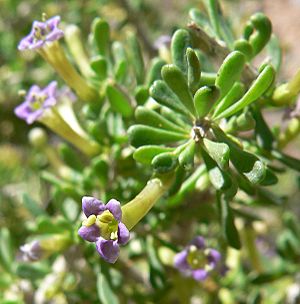Lycium andersonii facts for kids
Quick facts for kids Lycium andersonii |
|
|---|---|
 |
|
| Conservation status | |
| Scientific classification | |
| Genus: |
Lycium
|
| Species: |
andersonii
|
The Lycium andersonii is a cool plant often called the water-jacket or redberry desert-thorn. It's part of the nightshade family, which includes many different plants. You might also hear it called Anderson thornbush or Anderson wolfberry.
Contents
Where the Anderson Thornbush Lives
This plant is native to the Southwestern United States and northwestern Mexico. You can find it growing in places like New Mexico, Arizona, California, Nevada, and Utah. It also grows in parts of Baja California, Sinaloa, and Sonora in Mexico.
It likes many different types of environments. These include pinyon-juniper woodlands, creosote bush scrub, and sagebrush scrub. It can also be found in chaparral and coastal sage scrub areas.
What the Anderson Thornbush Looks Like
This plant is a shrub that can grow quite tall, up to about 2.7 meters (almost 9 feet). It has a big root system that can spread out over 9 meters (about 30 feet) from the plant's base.
The shrub is usually round in shape. It has many branches covered with thin spines, which can be up to 2 centimeters (about 0.8 inches) long. Its leaves are thick and a bit fleshy, growing up to 1.7 centimeters (about 0.7 inches) long. When conditions get dry, the plant sheds its leaves to save water.
The flowers of the Anderson thornbush are funnel-shaped. They can be white or have a purple tint, and they grow up to a centimeter (about 0.4 inches) long. After the flowers, the plant produces a red or orange berry. These berries are small, less than a centimeter long.
Where It Grows Best
The Anderson thornbush prefers to grow in sandy or gravelly areas. You can often spot it in washes, on slopes, and on mesas (flat-topped hills). It's a tough plant that can handle some salty soils and alkaline soils. This includes a type of hard soil called caliche. It really thrives in hot, dry climates.
While it's a common plant, it's rarely the most common plant in an area. It often grows alongside other desert plants. Some of its neighbors include creosote bush, yellow palo verde, and white bursage. You might also see it near smoke tree, Nevada ephedra, and Joshua tree.
How It Got Its Name
This plant was named after a person named Charles Lewis Anderson. It was named by a famous botanist named Asa Gray.


